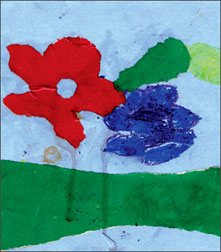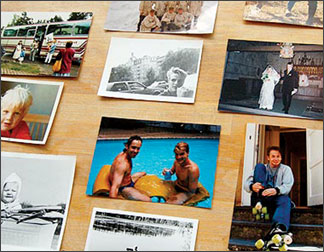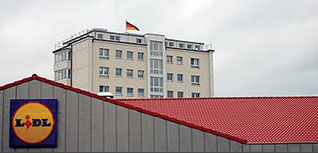Art
Paintings of courage
Psychotherapy through Arts
by Ranga Chandrarathne
[email protected]
 Psychotherapy through Arts is not an alien concept to Sri Lanka. This
has been practised over centuries through rituals. However, scientific
therapeutic art has rarely been practised in Sri Lanka in healing the
heart and minds of the patients. Psychotherapy through Arts is not an alien concept to Sri Lanka. This
has been practised over centuries through rituals. However, scientific
therapeutic art has rarely been practised in Sri Lanka in healing the
heart and minds of the patients.
The function recently held at the Children's ward of the Cancer
Hospital, Maharagama amply demonstrated the benefits that can be derived
from therapeutic art which had not only resulted in healing the tender
minds of the children but had also brought up host of talents in them.
The exhibition of paintings titled "Paintings of Courage" was the
culmination of the successful Therapeutic Arts Programme launched by the
Art Educationist of Sri Lanka and the Art Educationist Association and
Teachers College of Aesthetic Education at Giragama.
Speaking on the success story of the programme, Dr. Kanishka
Karunaratne, Director Cancer Hospital, Maharagama stated "There are over
hundred children receiving treatments from the hospital at any moment of
the time. Majority of these children aged 1-14 from diverse parts of the
country including North and East are suffering from cancer. The
treatment for cancer in children takes a long time and some of the
methods of treatments are complicated. The children need to stay at the
hospital for about two months. Generally a child stays with a mother.
 During these two months the children will miss school. And the
hospital conducts a programme to keep them occupied. Apart from their
physical suffering they undergo due to the ailment and treatment, the
hospital keeps their morale high by organizing host of activities. During these two months the children will miss school. And the
hospital conducts a programme to keep them occupied. Apart from their
physical suffering they undergo due to the ailment and treatment, the
hospital keeps their morale high by organizing host of activities.
For instance, we have a Play House. Once the children finish
treatment, they come to the Play House about 11 am and there is a
voluntary teacher at the school. Activities such as drawing, music are
offered for the children. Here the children's ideas are collected and
converted into a drawing. Some of the children cannot draw so the
teachers come forward and gather their ideas for them.
This type of activities is very important for mental rehabilitation
as child undergoes trauma. In cancer, we treat not only physical
ailments but also the mind. " He also stated that psychiatrist's service
has been obtained and when a child is admitted, the child and the
parents are referred to psychiatrist.
Counselling is provided to children and parents as there are
instances where father committed suicide unable to bear the tremendous
stress and depression.
He is of the view that all citizens should help the hospital even in
small ways as the treatment for cancer is expensive and the government
can not alone run the hospital.
The hospital is in need of funds for the setting up of a new ward,
setting up of a Cancer hostel which would serve outstation patients to
stay and receive treatment. In addition, financial aid is also required
for the project to construct a Surgical Unit and to purchase
state-of-Art equipments.
From the beaming faces, it was obvious that children had enjoyed
every bit of the programme. Perhaps, therapeutic art is one of the
effective methods of healing wounded minds and restoring confidence in
them.
In addition, the programme has brought otherwise hidden talents into
the lime light. The paintings displayed were very rich in colours as
well as in concepts that led to the drawings. Creations among other
things depict children's inherent qualities such as tenderness,
playfulness and some times sharp perception.
The Norwegian Embassy in Sri Lanka and Ambassador Tore Hattrem should
be commended for sponsoring this project which brought happiness to the
lives of the children at the Cancer hospital.
It should be mentioned here that the programme's success was not only
demonstrated in terms of creations by the children but the healing
process that brought out their talents into the limelight.
"Siddhartha" oriental ballet
A long way to perfection
by Indeewara Thilakarathne and Ranga Chandrarathne
"Siddhartha", oriental ballet presented by Rivega dance studio was
recently held at the Bishop College Auditorium. Though the ballet was an
impressive maiden performance by the young choreographers Rangika and
Rangana, "Siddhartha" has its share of shortcomings.
 Ballet is woven around the story of Siddhartha's chance meeting of
princess Sujatha who mistakes meditating Siddhartha as the deity of the
huge Nuga (banyan) three. The story concludes with the Siddhartha
achieving enlightenment defeating the ploy by three daughters of the
Maraya (Demon of all evils). The ballet is unfolded against the backdrop
of the banyan tree and the Siddhartha is represented by a flickering
flash light. Ballet is woven around the story of Siddhartha's chance meeting of
princess Sujatha who mistakes meditating Siddhartha as the deity of the
huge Nuga (banyan) three. The story concludes with the Siddhartha
achieving enlightenment defeating the ploy by three daughters of the
Maraya (Demon of all evils). The ballet is unfolded against the backdrop
of the banyan tree and the Siddhartha is represented by a flickering
flash light.
As a maiden attempt, "Siddhartha" though far from being perfect, has
shown some characteristics of young but maturing choreographers in
Rangika and Rangana. The idea of depicting "Siddhartha" with a light is
impressive idea. However, it should have been more impressive and
classical if a light shoots up beneath the tree. One significant
weakness is that costumes were highly Bollywood. The Bollywood influence
is pervasive throughout the festival.
Another fault is that the gross disregard of the traditional source
of the ballet. This is manifested in the troop of the Maraya which is
the climax of the ballet. Traditional Maraya's troop, by and largely,
consisted of men and not women as depicted in the ballet. Though girls
depicting the Mara troop are not inappropriate, the Bollywood-style
costumes have robbed the performance of its otherwise traditional
allure.
The character of the Maraya, which is in fact the pivotal character,
has not been exploited. It would have better if a soul of Maraya was
included in the ballet. However, the arrangements of characters and
inclusion of the story elements such as offering milk rice by prince
Sujatha to Siddhartha and characters like Soththiya in the ballet were
somewhat impressive. Bollywood-style costumes virtually marred the
ballet depriving it of its traditional allure.
Rangika, Rangana and their troupe Rivega have a long way to tread
towards realizing artistic goals. It is obvious that the troupe has a
seed of ample talents. However, this seed needs to be nurtured and
nourished with knowledge and training in order to grow it to be mature
and accomplished artistes.
The dance based on "Gajaga Vannama" which followed the "Siddhartha"
was a dance which captured the elegant movements of the elephant. This
is a traditional up country dance which is famous for its grandeur and
movements mimicking the elephant's movements. Even here the weakness in
choreography is evident.
The 'Rain' is an innovative dance item. Here the wind, lighting and
the atmosphere of a torrential rain is recreated on the stage through
the expertly manipulation of sound and light. This item showed that
Rivega is capable of innovative. The 'Rain' depicts the joy of being
soaked in the rain which is rarely happens in reality. Decorative
umbrellas are, somewhat, similar to those used in the Kandyan era. The
'Rain' is one of the items which excelled in costume-design.
Api Lokko is collective dance by children depicting the motto "Unity
is strength". The dance was performed to the song in the film "Handaya"
by Titus Totawatte.
The rest of the items include Naree (A modern dance version of a
Tamil song), Eagle and Young girl, Pathuru, Swans, Ran Menika, Thandom
and Debara. Debara (Wasp) is, somewhat, similar in costume to Kumbi
Katawa .
Florian Thalhofer
Work shop on media Art
by Indeewara Thilakarathne
[email protected]
"The era of plot and story has long passed. You can feel it in every
book, in every play, you can even feel it in the movies. Plot and story
cause panic by speeding up the course of time, by presenting causalities
and conflicts that do not exist. Dramatic composition and rising actions
are metaphysics. They manifest the belief in beings outside our space
and time, Beings that determine our fate. Plot and story provide a
classification system that hardly differs from the classification
systems of religious schools of thought." says Florian Thalhofer who
conducted a work shop on Media Art.
 The interactive workshop was based on his project iStory BOX. The
media art programme was developed during an Art-in-residence project of
the Goethe Institute in Cairo. Thalhofer gathered his material in
diverse ways; filming and taking photographs, listening to people's
stories and them arranged the information in a nonlinear format which he
has developed into software and named as "Korsakow System". The interactive workshop was based on his project iStory BOX. The
media art programme was developed during an Art-in-residence project of
the Goethe Institute in Cairo. Thalhofer gathered his material in
diverse ways; filming and taking photographs, listening to people's
stories and them arranged the information in a nonlinear format which he
has developed into software and named as "Korsakow System".
As Thalhofer believes that life is not in a linear format and things
happened not in an organised manner. The interactive software enables
the user to explore the storyline at his or her will.
Some of the projects discussed during the workshop include [Forgotten
Flags] 2007, interactive installation, website, DVD-rom, collaboration
with Juliane Henrich, [13terStock] 2005, interactive installation,
website, DVD-rom, collaboration with Kolja Mensing, published by
 Verbrecher-Verlag, Berlin, [7sons] 2003 interactive installation,
Website, CD-rom, in collaboration with Mahmoud Hamdy, [LoveStoryProject]
2002, interactive installation, Website, CD-rom, in collaboration with
Mahmoud Hamdy, [Korsakow Syndrom] nonlinear and interactive documentary
film, 2000, [Get Rich With Art] 1999, CD-Rom and board-game,collaboration
with Anja Lutz and Jim Avignon, published by shift! Magazine and [kleine
welt] / [small world] 1997, CD-Rom, published 1999 by Mediamatic,
Amsterdam. Florien Thalhofer is recipient of many awards including
Literature digital, the Reddot design award and Werkleitz Award. Verbrecher-Verlag, Berlin, [7sons] 2003 interactive installation,
Website, CD-rom, in collaboration with Mahmoud Hamdy, [LoveStoryProject]
2002, interactive installation, Website, CD-rom, in collaboration with
Mahmoud Hamdy, [Korsakow Syndrom] nonlinear and interactive documentary
film, 2000, [Get Rich With Art] 1999, CD-Rom and board-game,collaboration
with Anja Lutz and Jim Avignon, published by shift! Magazine and [kleine
welt] / [small world] 1997, CD-Rom, published 1999 by Mediamatic,
Amsterdam. Florien Thalhofer is recipient of many awards including
Literature digital, the Reddot design award and Werkleitz Award.
Dr. Mahesh Perera's "Hiragedarata Dorakna" (Prison without a door)
will be held on March 15, 2008 at the O. A. E. Perera theatre at the
University of Peradeniya. The performance is organised by the 90th year
batch of the Peradeniya graduates. The Vice Chancellor of the University
of Peradeniya, Prof. Nimal Senanayake will grace the occasion. The
get-together of 90th group will be held at the Agricultural Training
Centre in Gannoruwa. The cast include Gamini Samarakoon and Lincoln
Mandawala while Gayan Ganakadara composed music for the drama. |
